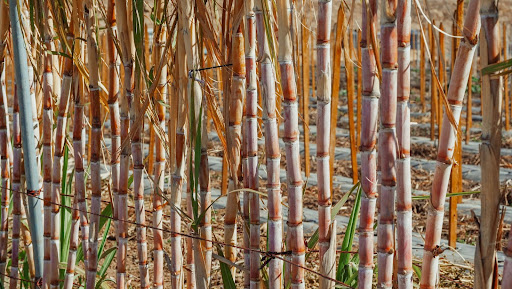The role of sugar beet vs sugar cane in shaping economic strategies
All You Need to Understand About Sugar Beet Vs Sugar Cane: Insights Into Their Duties in the Cane Sugar Industry
The sugar market depends heavily on both sugar beet and sugar cane, each offering one-of-a-kind benefits and obstacles. Understanding their farming approaches, geographic distribution, and dietary impacts exposes significant differences. As consumer preferences shift, the sector faces pushing needs for sustainability and advancement. Discovering these facets can give deeper understandings into the future of sugar and their functions in the worldwide market. What growths exist in advance for these essential plants?
Introduction of Sugar Beet and Sugar Cane
Sugar beet and sugar cane are two primary resources of sucrose, each with one-of-a-kind features and growing techniques. Sugar beet, an origin vegetable, prospers in warm environments and is often expanded in regions with cooler temperature levels. It has a high sugar content, usually about 16 to 20 percent, which is drawn out with a procedure of cutting and diffusion. On the other hand, sugar cane is a tropical yard that thrives in cozy, humid climates. Its stalks can include 10 to 15 percent sucrose, and the extraction process typically involves crushing the stalks to launch the juice.Both crops play considerable roles in the global sugar sector, with sugar beet mostly cultivated in Europe and The United States And Canada, while sugar cane is primarily grown in countries like Brazil, India, and China. Sugar beet vs sugar cane. This geographical distribution reflects the different climatic demands and agricultural techniques suited to every plant, affecting their respective payments to sugar manufacturing worldwide
Cultivation Approaches and Expanding Conditions
The cultivation techniques and expanding conditions for sugar beets and sugar cane differ greatly due to their unique dirt and climate requirements. Sugar beetroots thrive in cooler climates with well-drained, fertile dirts, while sugar cane likes warmer temperatures and can endure poorer dirts. On top of that, the harvesting strategies for both plants vary, showing their special expanding methods and environmental adaptations.
Soil Requirements Contrast
While both sugar beet and sugar cane are crucial sources of sugar, their soil needs reflect unique preferences that affect growing techniques and expanding problems. Sugar beets flourish in well-drained, loamy soils abundant in natural issue, with a pH array of 6.0 to 8.0. This sort of soil sustains their deep taproots, making it possible for nutrition absorption. Conversely, sugar cane chooses productive, sandy loam or clay dirts that maintain moisture, ideally with a pH between 6.0 and 7.5. The origin system of sugar cane is more extensive, needing dirt that can sustain its growth in a more water-retentive environment. These differing soil demands demand customized farming methods to optimize returns for every plant, emphasizing the relevance of dirt monitoring in their farming.
Climate Versatility Differences

Collecting Techniques Introduction
Gathering techniques for sugar beet and sugar cane vary significantly as a result of their distinctive growing approaches and growing problems. Sugar beet is usually harvested mechanically utilizing specific tools that uproots the plants and divides the roots from the foliage. This procedure is normally conducted in cooler months to stop perishing. In contrast, sugar cane harvesting commonly entails manual work or mechanical cutters, where stalks are reduced short. This technique is performed throughout the dry period to reduce the dampness web content, which can affect sugar yield. Furthermore, the timing of the harvest is critical, as both crops require to be collected when they reach peak sugar concentration for reliable processing.
Geographical Distribution and Production Data
Although both sugar click to investigate beet and sugar cane offer as essential sources of sucrose, their geographical circulation and production stats expose remarkable differences. Sugar cane primarily flourishes in tropical and subtropical climates, with major production areas consisting of Brazil, India, China, and Thailand. On the other hand, sugar beet is mainly cultivated in pleasant regions, with leading manufacturers situated in Europe, the USA, and Russia.According to recent stats, international sugar cane production substantially exceeds that of sugar beet. In 2021, sugar cane made up around 79% of complete sugar production worldwide, while sugar beet contributed around 21%. Brazil stays the world's largest sugar manufacturer, mostly from sugar cane, generating over 38 million metric loads yearly. The United States is one of the leading sugar beet producers, generating regarding 5 million statistics loads each year. These stats underscore the important function each crop plays in the worldwide sugar market

Nutritional Differences and Health Impacts
The dietary make-up of sugar beet and check that sugar cane differs significantly, affecting their corresponding health effects. Sugar beet tends to consist of greater degrees of particular vitamins and minerals, while sugar cane uses a various collection of nutrients. Recognizing these distinctions is important for reviewing their results on health and wellness and dietary selections.
Nutrient Structure Comparison
When comparing the nutrient make-up of sugar beet and sugar cane, significant differences emerge that can affect wellness end results. Sugar beets are understood to supply a higher focus of important nutrients, including vitamins B6 and C, potassium, and magnesium. In contrast, sugar cane often tends to have lower degrees of these nutrients, mainly acting as a carb source. Sugar beets likewise have nutritional fiber, which is advantageous for digestive health and wellness, while sugar cane lacks this component. In addition, the visibility of anti-oxidants in sugar beets adds to possible health and wellness benefits, unlike sugar cane, which is largely composed of sucrose. These distinctions highlight the varying dietary accounts of both sources, which can impact consumer choices and dietary factors to consider.

Health And Wellness Results Introduction
While both sugar beet and sugar cane are extensively used for sugar production, their distinctive nutritional accounts lead to varying health results. Sugar beet commonly consists of greater degrees of vitamins and minerals, such as potassium and magnesium, contributing to better total dietary worth. Alternatively, sugar cane's juice is abundant in anti-oxidants, which may provide added health and wellness benefits.However, both sources primarily yield sucrose, which, when consumed over, poses risks such as obesity, diabetes mellitus, and heart condition. The glycemic index of sugar cane is often somewhat less than that of sugar beet, potentially making it a better choice for blood sugar level management. Ultimately, moderation is necessary for both kinds to alleviate damaging health influences related to high sugar consumption.
Ecological Considerations in Sugar Production
Although sugar manufacturing from both sugar beet and sugar cane uses financial benefits, it also raises significant environmental concerns. The growing of these crops typically entails extensive land use, which can bring about environment destruction and loss of biodiversity. Additionally, making use of fertilizers and pesticides in sugar farming adds to dirt degradation and water contamination, influencing local ecosystems.The high water intake required for watering, especially in sugar cane manufacturing, intensifies water deficiency problems in some regions. Additionally, deforestation for increasing sugar cane vineyards has been linked to enhanced greenhouse gas discharges, additionally adding to climate change.Sustainable farming methods, such as crop turning and chemical-free farming, are vital to reduce these environmental impacts. Sector stakeholders are increasingly recognizing the requirement for liable growing approaches to guarantee the lasting viability of sugar production while minimizing damage to the planet.
Economic Relevance in the Global Market
The environmental difficulties connected with sugar production highlight the need to examine its financial relevance in the worldwide market. Sugar beet and sugar cane are pivotal to the farming economy, contributing considerably to the livelihoods of millions worldwide. In 2022, the worldwide sugar market was valued at around $50 billion, with sugar cane audit for most of manufacturing. Countries such as Brazil, India, and China are leading producers, influencing you can check here global supply chains and pricing structures. The competitors in between sugar beet and sugar cane likewise influences regional economic situations, as farmers choose plants based upon market needs and climatic problems. Additionally, the sugar industry sustains secondary fields, consisting of food processing and biofuel manufacturing, boosting its total financial impact. As consumer preferences shift towards much healthier alternatives, the economic dynamics of sugar manufacturing may evolve, demanding continuous analysis of its market importance in a changing worldwide landscape.
Future Trends and Advancements in Sugar Production
As the worldwide need for sugar proceeds to advance, advancements in sugar production are arising to deal with sustainability and effectiveness obstacles. One notable fad is the boosted fostering of precision agriculture modern technologies, which make it possible for farmers to enhance yields while lessening environmental influences. In addition, innovations in reproducing techniques, such as CRISPR gene editing, are being explored to develop sugar plants with enhanced resistance to bugs and conditions, consequently minimizing the requirement for chemical inputs.Moreover, the integration of renewable resource sources in sugar handling plants is acquiring traction, helping to reduced carbon footprints. The fad towards bioprocessing is additionally substantial, as business look to transform by-products right into value-added items like biofuels and bioplastics. Consumer preferences are moving towards all-natural sweeteners, prompting research into alternate sources like stevia and monk fruit, which may improve the landscape of the sugar industry in the coming years.
Often Asked Inquiries
How Do Sugar Beet and Sugar Cane Preference In A Different Way?
Sugar beet and sugar cane exhibit unique flavor accounts. Sugar beet often tends to have a somewhat natural sweet taste, while sugar cane provides a more robust, syrupy sweet taste, adding to their distinct cooking applications and preferences among customers.
Can Sugar Beet and Sugar Cane Be Used Reciprocally in Recipes?
Sugar beet and sugar cane can be used interchangeably in dishes, though their tastes and sweet taste degrees might differ somewhat. Changes may be needed to accomplish the desired taste and texture in cooking applications.
What Are the By-Products of Sugar Beet and Sugar Cane Processing?
The spin-offs of sugar beet and sugar cane handling consist of molasses, bagasse, and pulp (Sugar beet vs sugar cane). These materials are made use of in pet feed, biofuel manufacturing, and different industrial applications, enhancing sustainability and reducing waste in the sugar industry
Are There Any Type Of Different Makes Use Of for Sugar Beet Besides Sugar Production?
The different usages for sugar beet prolong beyond sugar manufacturing. They include livestock feed, biofuel production, and the removal of plant-based chemicals, showcasing sugar beet's convenience within farming and commercial applications.
Exactly How Does Environment Adjustment Affect Sugar Beet and Sugar Cane Crops?
Environment adjustment impacts sugar beet and sugar cane plants by altering temperature and precipitation patterns. Raised heat tension, drought, and moving pest populations can minimize returns, testing farmers to adjust their techniques for sustainable manufacturing.